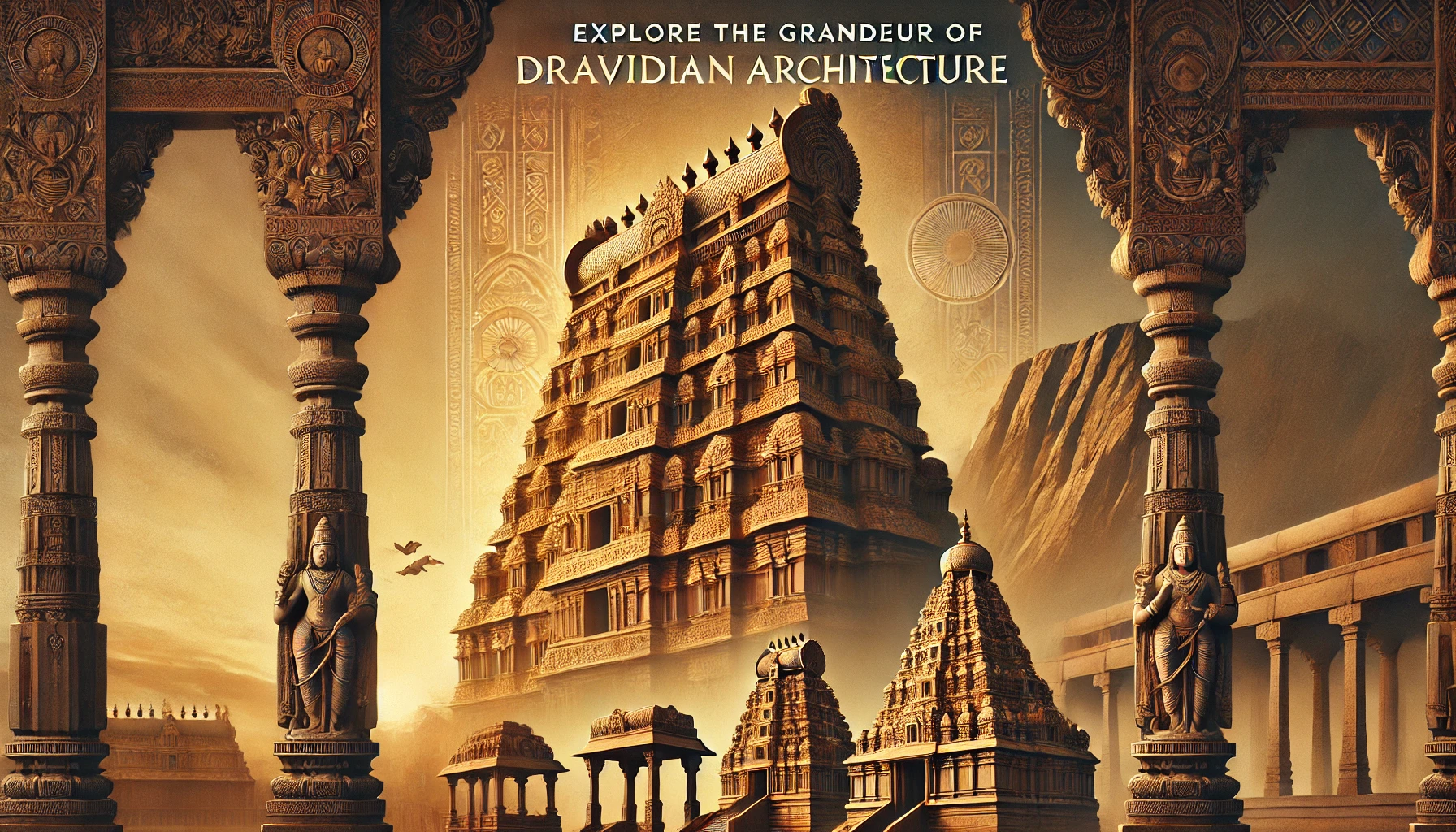Dravidian architecture, a hallmark of South India, represents a timeless blend of artistry, spirituality, and history. Characterized by towering gopurams, intricate carvings, and grand temple complexes, this architectural style has fascinated historians, architects, and spiritual seekers alike.
From the temples of Tamil Nadu to the sacred shrines of Karnataka and Andhra Pradesh, Dravidian architecture stands as a testament to the region’s rich cultural heritage. This guide delves into the unique features, historical significance, and prominent examples of this remarkable architectural tradition.
What is Dravidian Architecture?
Dravidian architecture refers to a distinct style of temple construction that originated in South India during the Sangam period (circa 300 BCE–300 CE). It flourished under the patronage of dynasties such as the Pallavas, Cholas, Pandyas, and Vijayanagara rulers.
This style is known for its pyramid-shaped towers (gopurams), elaborate stone carvings, and sprawling temple complexes designed as cosmic representations of the universe. Moreover, these temples served not only as places of worship but also as cultural and administrative centers.
Key Features of Dravidian Architecture
- Gopurams
The towering gateways, or gopurams, are among the most defining features of Dravidian architecture. Adorned with colorful sculptures depicting deities, mythical creatures, and stories from epics, they serve as visual narrators of Hindu mythology. - Vimana
The vimana refers to the inner sanctum tower, typically shorter than the gopuram but equally intricate. It houses the main deity and is often crowned with a kalasha (a decorative finial). - Mandapams
Mandapams are pillared halls within the temple complex, used for gatherings, rituals, and cultural performances. The pillars often feature detailed carvings of gods, animals, and floral patterns. - Sacred Tanks and Prakarams
Many Dravidian temples include sacred tanks for ritualistic bathing and concentric enclosures (prakarams) that guide devotees toward the sanctum. - Granite and Sandstone Construction
These temples were predominantly constructed using locally available granite and sandstone, showcasing the craftsmanship and resourcefulness of ancient artisans.
Historical Evolution of Dravidian Architecture
Early Beginnings: The Sangam Period
Dravidian architecture began taking shape during the Sangam period, with small, simplistic shrines dedicated to regional deities.
Pallava Dynasty (4th–9th Century)
Under the Pallavas, temple architecture evolved significantly. Monolithic rock-cut temples like the Shore Temple and Pancha Rathas in Mahabalipuram stand as iconic examples of this era.
Chola Dynasty (9th–13th Century)
The Cholas elevated Dravidian architecture to new heights by constructing massive temples like the Brihadeeswarar Temple in Thanjavur. These temples featured complex vimanas, sculptures, and frescoes.
Vijayanagara Empire (14th–17th Century)
The Vijayanagara rulers added grandeur with massive gopurams and expansive temple complexes, such as the Virupaksha Temple in Hampi. Their contributions emphasized symmetry, scale, and ornamental detail.
Famous Examples of Dravidian Architecture
- Meenakshi Amman Temple (Madurai)
A masterpiece of Dravidian artistry, this temple features 14 gopurams and intricate carvings. The temple’s Thousand Pillar Hall is a prime example of exquisite craftsmanship. - Brihadeeswarar Temple (Thanjavur)
Known as the “Big Temple,” it is a UNESCO World Heritage Site. Its 66-meter tall vimana is among the tallest in South India. - Ranganathaswamy Temple (Srirangam)
Spread over 156 acres, it is the largest functioning Hindu temple complex in the world. The temple features 21 gopurams, each a testament to architectural brilliance. - Virupaksha Temple (Hampi)
This temple showcases the grandeur of Vijayanagara architecture with its towering gopuram and beautifully carved interiors. - Chennakesava Temple (Belur)
A blend of Dravidian and Hoysala styles, this temple is renowned for its intricate carvings depicting deities, dancers, and animals.
Symbolism in Dravidian Architecture
Dravidian temples are not mere places of worship; they are cosmic diagrams representing the universe. The layout often mirrors the human body, with the sanctum (garbhagriha) symbolizing the head, the gopuram representing the feet, and the mandapams acting as the body. This symbolism highlights the connection between humans and the divine.
Preservation and Modern Relevance
Preserving Dravidian temples is vital to safeguarding South India’s cultural and spiritual heritage. Organizations like UNESCO and the Archaeological Survey of India work hard. Their efforts have ensured the protection and restoration of many ancient sites.
Furthermore, these temples continue to inspire modern architecture, art, and even cinematic depictions, ensuring their relevance in contemporary culture.
FAQs
Dravidian architecture is a style of temple construction in South India characterized by pyramid-shaped towers, intricate carvings, and grand temple complexes.
The Chola Dynasty made significant contributions, building massive temples like the Brihadeeswarar Temple in Thanjavur.
Gopurams are towering gateways in Dravidian temples adorned with detailed sculptures narrating Hindu mythology.
Granite and sandstone were predominantly used, showcasing the skill of ancient artisans.
These temples serve as spiritual centers and cultural landmarks, representing South India’s rich heritage.
Yes, examples include the Brihadeeswarar Temple and the Shore Temple in Mahabalipuram.
Conclusion
Dravidian architecture is a testament to South India’s artistic excellence and spiritual depth. Each temple, from the Brihadeeswarar Temple to the Meenakshi Amman Temple, tells a story of devotion and craftsmanship that transcends time. Exploring these magnificent structures offers not only a glimpse into history but also a profound connection to India’s cultural roots.
Suggestions:




One thought on “Guide to Dravidian Architecture: Exploring South India’s Timeless Marvels”